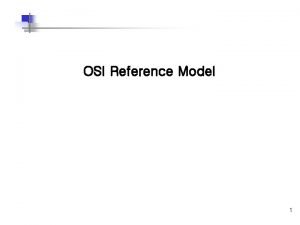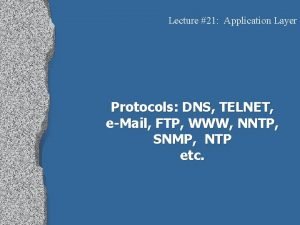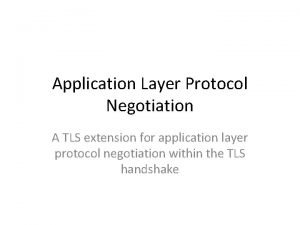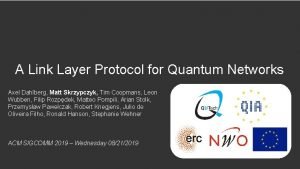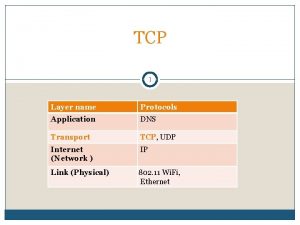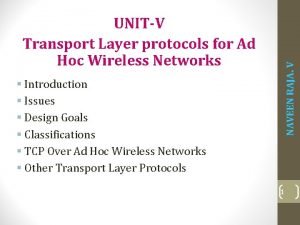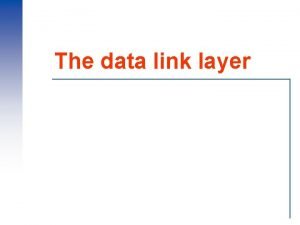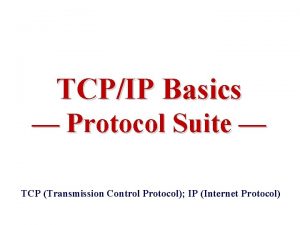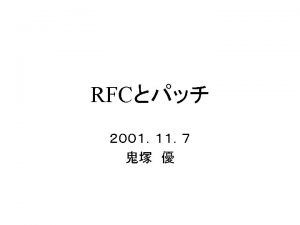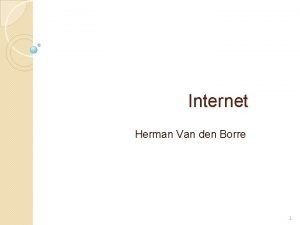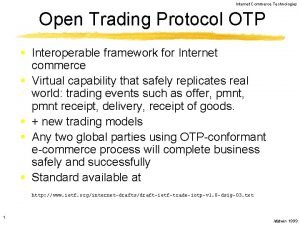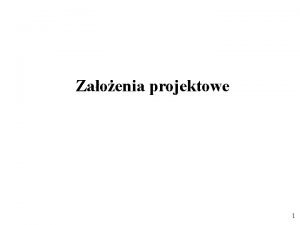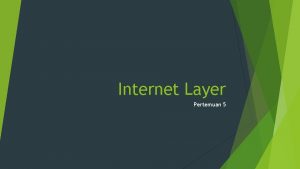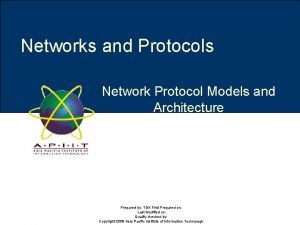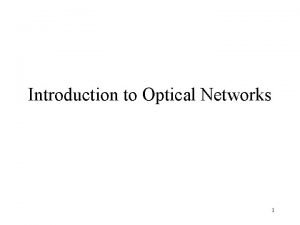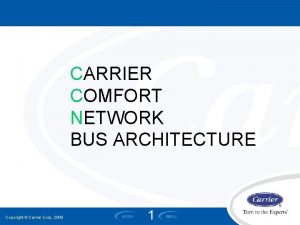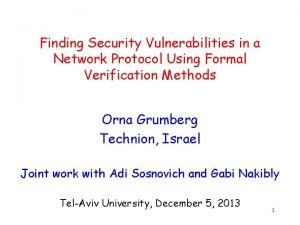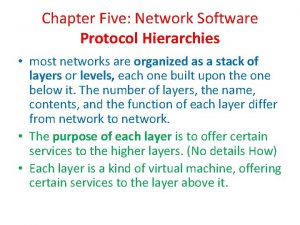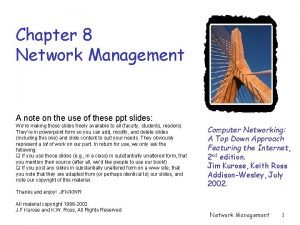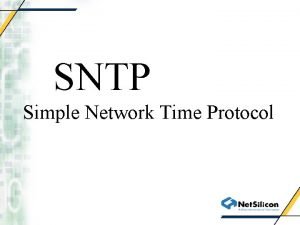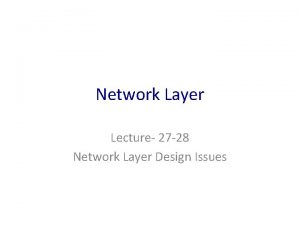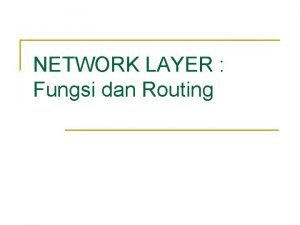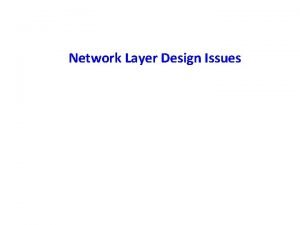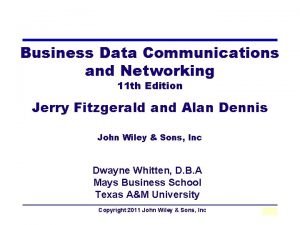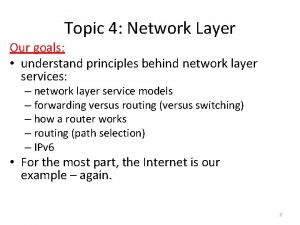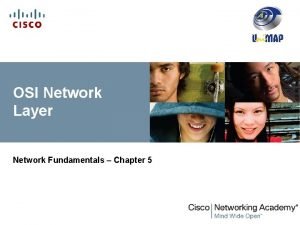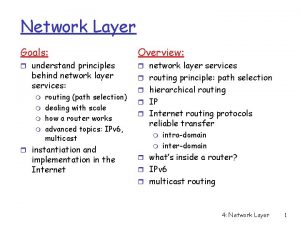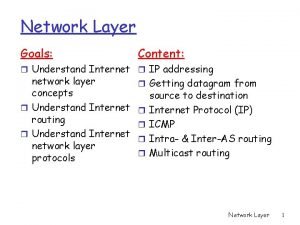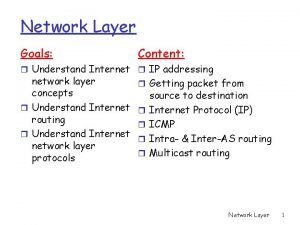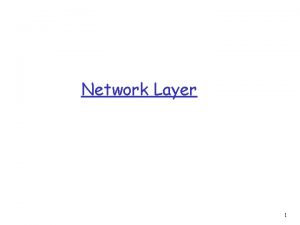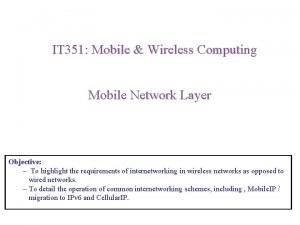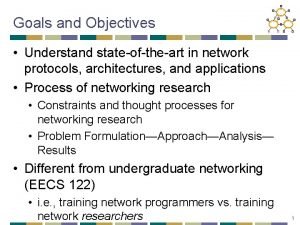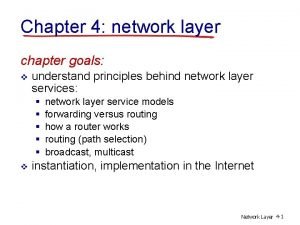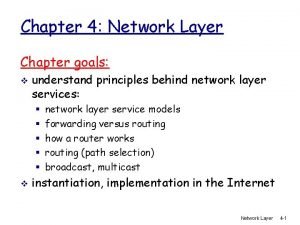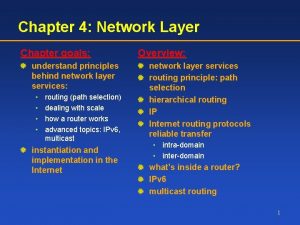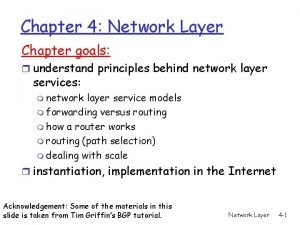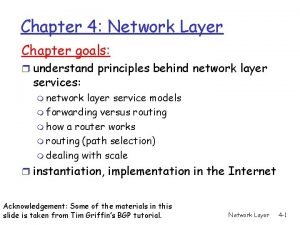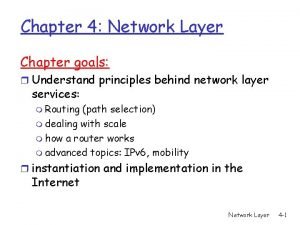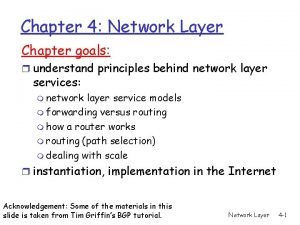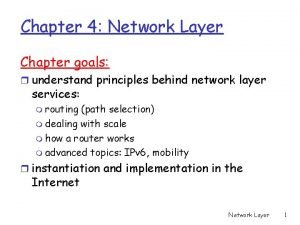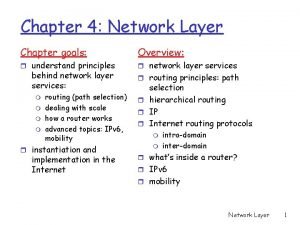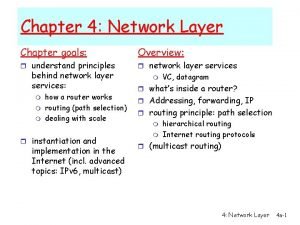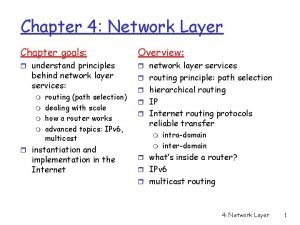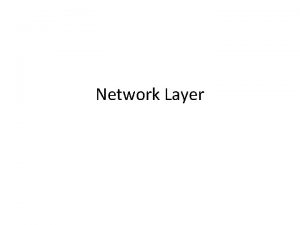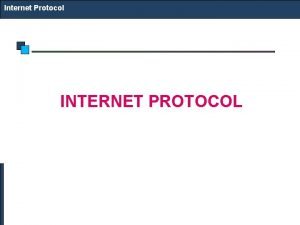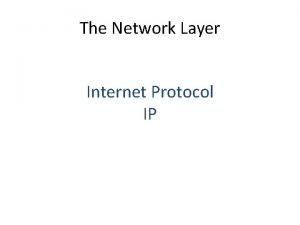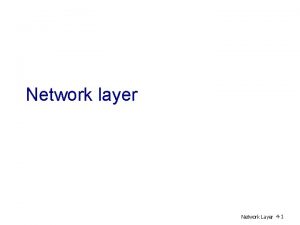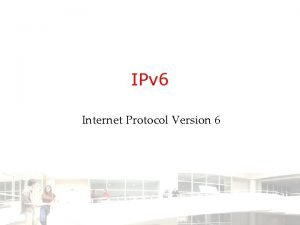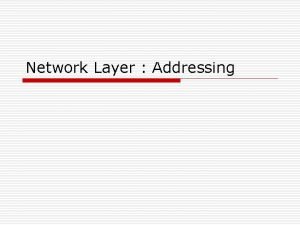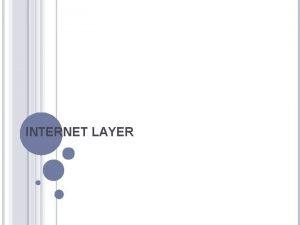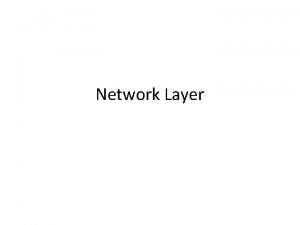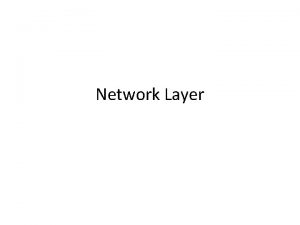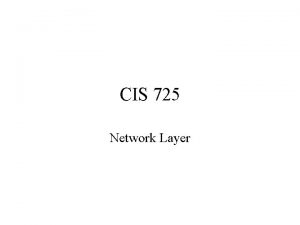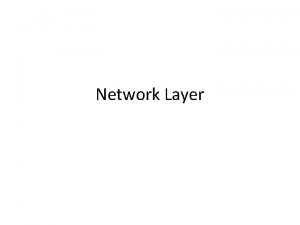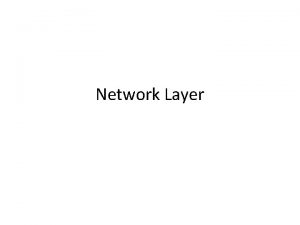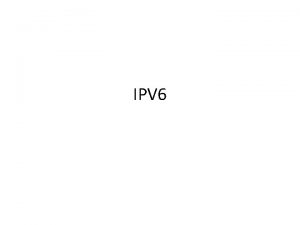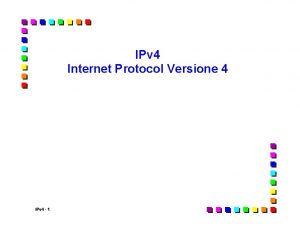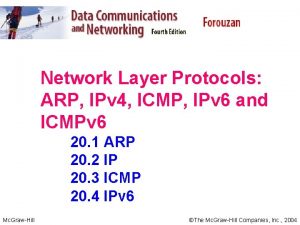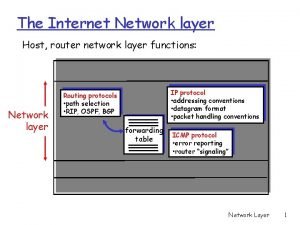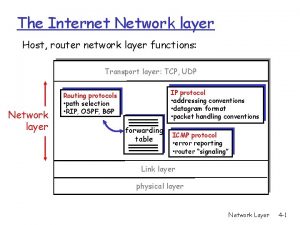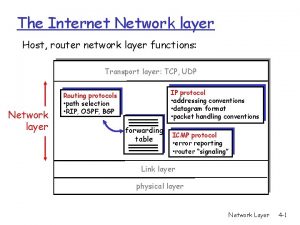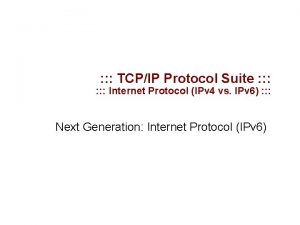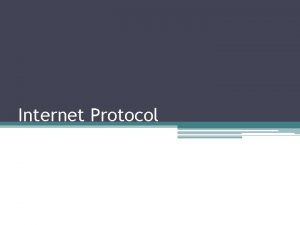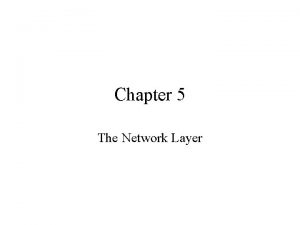Unit 6 Network Layer Internet Protocol Ipv 4




































































- Slides: 68

Unit – 6 Network Layer: Internet Protocol • Ipv 4 and Ipv 6 • Transition from Ipv 4 to Ipv 6. 04�820 Unit-VI Network Layer 1

Network Layer Physical and data link layers of a network operate locally. In the Internet model, the main network protocol is the Internet Protocol (IP) Concerned with getting packets from source to destination. The network layer must know the topology of the subnet and choose appropriate paths through it. When source and destination are in different networks, the network layer (IP) must deal with these differences. 04�820 Unit-VI Network Layer 2

IP is the highest layer protocol which is implemented at both routers and hosts 04�820 Unit-VI Network Layer 3

IP Service IP provides an unreliable connectionless best effort service (also called: “datagram service”). • Unreliable: IP does not make an attempt to recover lost packets • Connectionless: Each packet (“datagram”) is handled independently. IP is not aware that packets between hosts may be sent in a logical sequence • Best effort: IP does not make guarantees on the service (no throughput guarantee, no delay guarantee, …) Consequences: • Higher layer protocols have to deal with losses or with duplicate packets • Packets may be delivered out-of-sequence 04�820 Unit-VI Network Layer 4

IP Service IP supports the following services: • one-to-one (unicast) • one-to-all (broadcast) • one-to-several (multicast) unicast broadcast multicast IP multicast also supports a many-to-many service. IP multicast requires support of other protocols (IGMP, multicast routing) 04�820 Unit-VI Network Layer 5

INTERNETWORKING In this section, we discuss internetworking, connecting networks together to make an internetwork or an internet. Need for Network Layer Internet as a Datagram Network Internet as a Connectionless Network 04�820 Unit-VI Network Layer 6

Links between two hosts • 5 networks, 4 LANs and 1 WAN. • A->S 1 ->S 3 ->D, Physical and Data Link layer are involved. • Data link and Physical link layer does not have the routing information. 04�820 Unit-VI Network Layer 7

Links between two hosts Need for Network Layer • When data arrives at interface f 1 of Router 1(R 1), how does R 1 know that interface f 3 is the outgoing interface ? • There is no provision in the data link layer to help R 1 make the decision. • The frame does not carry any routing information. • The frame contains the MAC address of A as the source address and MAC address of R 1 as the destination address. Solution: • To solve this problem the network layer was designed. • The network is responsible for host-to-host delivery and for routing the packets through the routers or switches. 04�820 Unit-VI Network Layer 8

Network layer in an internetwork • Header of the packet contains logical addresses of the source and destination. • Network layer maintains Routing table 04�820 Unit-VI Network Layer 9

Network layer at the source, router, and destination • Network Layer at the source is responsible for creating a packet from the data coming from another protocol. • The header of the packet contains, among other information , the logical addresses of the source and destination. • Network Layer is responsible for checking its routing table to find the routing information. • Network Layer at the destination is responsible for address verification 04�820 Unit-VI Network Layer 10

Network layer at the source, router, and destination • Network Layer at the router is responsible for routing the packets. • Router or switch consults its routing table and finds the interface from which the packet must be sent. 04�820 Unit-VI Network Layer 11

Switching Techniques Three types of switching techniques: • Circuit Switching • Packet Switching • Message Switching (a) Circuit switching. (b) Packet switching. 04�820 Unit-VI Network Layer 12

Circuit Switching Dedicated communication path between two stations Three phases • Establish • Transfer • Disconnect Must have switching capacity and channel capacity to establish connection Must have intelligence to work out routing Inefficient • Channel capacity dedicated for duration of connection • If no data, capacity wasted Set up (connection) takes time Once connected, transfer is transparent Developed for voice traffic (phone) 04�820 Unit-VI Network Layer 13

Public Circuit Switched Network Circuit switching designed for voice • Resources dedicated to a particular call • Much of the time a data connection is idle • Data rate is fixed • Both ends must operate at the same rate 04�820 Unit-VI Network Layer 14

Packet Switching Principles Basic Operation Data transmitted in small packets • Typically 1000 octets • Longer messages split into series of packets • Each packet contains a portion of user data plus some control info Control info • Routing (addressing) info Packets are received, stored briefly (buffered) and past on to the next node • Store and forward 04�820 Unit-VI Network Layer 15

Use of Packets 04�820 Unit-VI Network Layer 16

Packet Switching Technique Station breaks long message into packets Packets sent one at a time to the network Packets handled in two ways • Datagram • Virtual circuit 04�820 Unit-VI Network Layer 17

Datagram Each packet treated independently Packets can take any practical route Packets may arrive out of order Packets may go missing Up to receiver to re-order packets and recover from missing packets 04�820 Unit-VI Network Layer 18

Datagram Diagram 04�820 Unit-VI Network Layer 19

Internet as Datagram Network The internet is packet switched network and uses datagram approach to switching in the network layer. Uses universal addresses defined in the network layer to route packets from the source to destination. 04�820 Unit-VI Network Layer 20

Internet as a Connectionless Network Connection-oriented Protocols • A setup stage is used to determine the end-to-end path before a connection is established. • Data flow streams are identified by some type of connection indicator • Packets are sent on the same path in sequential order. • Connection is terminated when all the packets are delivered Connectionless Protocols • No set up is needed. • Each packet contains information which allows the packet to be individually routed hop-by-hop through the network. • Packets may or may not have travel the same path to the destination. • Internet used this type of service because it is impossible to connection from source to destination 04�820 Unit-VI Network Layer 21

Connection-Oriented Concatenation of Virtual Circuits Internetworking using concatenated virtual circuits. 04�820 Unit-VI Network Layer 22

Connectionless Internetworking A connectionless internet. 04�820 Unit-VI Network Layer 23

Switching at the network layer in the Internet uses the datagram approach to packet switching. Communication at the network layer in the Internet is connectionless. 04�820 Unit-VI Network Layer 24

IPv 4 The Internet Protocol version 4 (IPv 4) is the delivery mechanism used by the TCP/IP protocols. IPv 4: Connectionless Datagram protocol Best effort protocol and does not provides error and flow control (error detection on the header) Datagram Fragmentation Checksum Options 04�820 Unit-VI Network Layer 25

Position of IPv 4 in TCP/IP protocol suite 04�820 Unit-VI Network Layer 26

Datagram • Packets in the IPv 4 layer are called datagrams. 04�820 Unit-VI Network Layer 27

IPv 4 datagram format • • Packets in the IPv 4 layer are called datagrams. Consists of Header and Data 04�820 Unit-VI Network Layer 28

VER HLEN Service Total Length Flags Fragment Offset TTL Protocol Header Checksum Source/Destination IP Addresses Options • Version (VER): is the field that contains the IP protocol version. The current version is 4. 5 is an experimental version. 6 is the version for IPv 6. • Header Length (HLEN): is the length of the IP header in multiples of 32 bits, without the data field. • The minimum value for a correct header is 5 (i. e. , 20 bytes), the maximum value is 15 (i. e. , 60 bytes). 04�820 Unit-VI Network Layer 29

VER HLEN Service Total Length Flags Fragment Offset TTL Protocol Header Checksum Source/Destination IP Addresses Options • Service Type: (8 bit) is an indication of the quality of service requested for this IP datagram. It contains the following information. • Precedence: ( first 3 bits) specifies the nature/priority: of the datagaram in issues such as congestion. • 000: Routine 001: Priority 010: Immediate 011: Flash 100: Flash override 101: Critical 110: Internetwork control 111: Network control • The next 4 bits are called type of service (TOS) bits, 04�820 Unit-VI Network Layer 30

VER HLEN Service Total Length Flags Fragment Offset TTL Protocol Header Checksum Source/Destination IP Addresses Options • The last bit is reserved for future use. 04�820 Unit-VI Network Layer 31

Default types of service 04�820 Unit-VI Network Layer 32

VER HLEN Service Total Length Flags Fragment Offset TTL Protocol Header Checksum Source/Destination IP Addresses Options Values for codepoints • Internet Control Message Protocol: ICMP Internet Group Management Protocol: IGMP Transmission Control Protocol: TCP User Datagram Protocol: UDP Open Shortest Path First: OSPF Bootstrap Protocol: BOOTP, Simple Network Management Protocol: SNMP Interior gateway protocol IGP) Simple Network Management Protocol (SNMP) Trivial File Transfer Protocol (TFTP) Domain Name System (DNS) 04�820 Unit-VI Network Layer 33

VER HLEN Service Total Length Flags Fragment Offset TTL Protocol Header Checksum Source/Destination IP Addresses Options • Total Length: (16 bits) Specifies the total length of the IPv 4 datagram, header and data, in octets. 216 -1=65, 535 bytes. • Length of data = total length – header length • Identification: is a unique number assigned by the sender used with fragmentation. • Flags contains control flags: • – the first bit is reserved and must be zero; – the 2 nd bit is DF (Do not Fragment), 0 means allow fragmentation; – the third is MF (More Fragments), 0 means that this is the last fragment. 04�820 Unit-VI Network Layer 34

VER HLEN Service Total Length Flags Fragment Offset TTL Protocol Header Checksum Source/Destination IP Addresses Options Encapsulation of a small datagram in an Ethernet frame 04�820 Unit-VI Network Layer 35

VER HLEN Service Total Length Flags Fragment Offset TTL Protocol Header Checksum Source/Destination IP Addresses Options • Fragment Offset is used to reassemble the full datagram. The value in this field contains the number of 64 -bit segments (header bytes are not counted) contained in earlier fragments. If this is the first (or only) fragment, this field contains a value of zero. • TTL (Time to Live) specifies the time (in seconds) the datagram is allowed to travel. In practice, this is used as a hop counter to detect routing loops. 04�820 Unit-VI Network Layer 36

VER HLEN Service Total Length Flags Fragment Offset TTL Protocol Header Checksum Source/Destination IP Addresses Options • Protocol: 8 bit field indicates the higher level protocol to which IP should deliver the data in this datagram. E. g. , ICMP = 1; TCP = 6; UDP = 17. (Internet message control protocol, Internet group management protocol steam control transmission protocol transmission control protocol user datagram protocol open shortest path first) 04�820 Unit-VI Network Layer 37

VER HLEN Service Total Length Flags Fragment Offset TTL Protocol Header Checksum Source/Destination IP Addresses Options • Header Checksum is a checksum for the information contained in the header. If the header checksum does not match the contents, the datagram is discarded. • Source/Destination IP Addresses are the 32 -bit source/destination IP addresses. • Options: The header consists of 2 parts: fixed part and a variable part. Fixed part is of 20 bytes. The maximum size of the Variable part is 40 bytes. Variable-length field (there may be zero or more options) used for network testing and debugging • Padding is used to ensure that the IP header ends on a 32 bit boundary. The padding is zero 04�820 Unit-VI Network Layer 38

Fragmentation 04�820 Unit-VI Network Layer 39

Fragmentation • • • Process of dividing a datagram is called Fragmentation IP provides fragmentation/reassembly of datagrams. The maximum length of an IP datagram is 65, 535 bytes. When an IP datagram travels from one host to another, it may pass through different physical networks. Maximum transfer unit (MTU) • Each physical network has a maximum frame size, called maximum transmission unit (MTU), which limits the datagram length. • A fragment is treated as a normal IP datagram while being transported to their destination. • If one of the fragments gets lost, the complete datagram is considered lost. It is possible that fragments of the same IP datagram reach the destination host via multiple routes. • Finally, Since they may pass through networks with a smaller MTU than the sender’s one, they are subject to further fragmentation. 04�820 Unit-VI Network Layer 40

Maximum transfer unit (MTU) MTUs for some networks Fiber Data Distributed Interface (FDDI) Point-to-Point Protocol (PPP) 04�820 Unit-VI Network Layer 41

Fields Related to Fragmentation • Identification, Flags , Fragmentation offset Field • • At the destination host, data are reassembled into the original datagram. • Fragmentation does not alter this field. In order to reassemble the fragments, the receiving host allocates a storage buffer when the first fragment arrives. • The host also starts a timer. If the timer is exceeded and fragments remain outstanding, the datagram is discarded When subsequent fragments of the datagram arrive, data are copied into the buffer storage at the location indicated by the fragment offset field. When all fragments have arrived, the original unfragmented datagram is restored and passed to upper layers, if needed. • • Flags: 3 bit field 1 bit is reserved 2 nd bit do not fragment, The identification field set by the sending host is used together with the source and destination IP addresses in the datagram. D= 1 do not frag, D=0 fragment M=0 last fragment M=1 more fragments M 04�820 D M Unit-VI Network Layer 42

Example of Fragmentation A datagram with size 2400 bytes must be fragmented according to an MTU limit of 1000 bytes 04�820 Unit-VI Network Layer 43

IPv 6 04�820 Unit-VI Network Layer 44

IPv 6 The network layer protocol in the TCP/IP protocol suite is currently IPv 4. Although IPv 4 is well designed, data communication has evolved since the inception of IPv 4 in the 1970 s. IPv 4 has some deficiencies that make it unsuitable for the fast-growing Internet. Advantages Packet Format Extension Headers 04�820 Unit-VI Network Layer 45

Problems with IPv 4: Limited Address Space IPv 4 has 32 bit addresses. Flat addressing (only netid + hostid with “fixed” boundaries) Results in inefficient use of address space. Class B addresses are almost over. Addresses will exhaust in the next 5 years. IPv 4 is victim of its own success. IP does not permit route aggregation (limited supernetting possible with new routers) Mostly only class C addresses remain Number of networks is increasing very fast (number of routes to be advertised goes up) Very high routing overhead • lot more memory needed for routing table • lot more bandwidth to pass routing information • lot more processing needed to compute routes 04�820 Unit-VI Network Layer 46

Problems with IPv 4: Header & other Limitations Maximum header length is 60 octets. (Restricts options) Maximum packet length is 64 K octets. (Do we need more than that ? ) ID for fragments is 16 bits. Repeats every 65537 th packet. (Will two packets in the network have same ID? ) Variable size header. (Slower processing at routers. ) No ordering of options. (All routers need to look at all options. ) Lack of quality-of-service support. • Only an 8 -bit To. S field, which is hardly used. • Problem for multimedia services. No support for security at IP layer. Mobility support is limited. 04�820 Unit-VI Network Layer 47

IP Address Extension Strict monitoring of IP address assignment Private IP addresses for intranets • Only class C or a part of class C to an organization • Encourage use of proxy services • Application level proxies • Network Address Translation (NAT) Remaining class A addresses may use CIDR Reserved addresses may be assigned But these will only postpone address exhaustion. They do not address problems like Qo. S, mobility, security. 04�820 Unit-VI Network Layer 48

IPv 6: Distinctive Features Larger Address space (128 bits) Better header format Header format simplification Expanded routing and addressing capabilities Improved support for extensions and options Flow labeling (for Qo. S) capability Auto-configuration and Neighbour discovery Authentication and privacy capabilities Simple transition from IPv 4 04�820 Unit-VI Network Layer 49

IPv 6: Packet format IPv 6 datagram header and payload 04�820 Unit-VI Network Layer 50

IPv 6 Header Format 0 4 12 Vers PRI Traffic Class Payload Length 16 24 31 Flow Label Next Header Hop Limit Source Address Destination Address 04�820 Unit-VI Network Layer 51

IPv 6 Header Format 04�820 Unit-VI Network Layer 52

VER PRI Flow Label Payload Length Next Header Hop limit Source/Destination IP Addresses Options Priority Version number (4 -bit field): The value is always 6. Priority: 4 bit filed defines the priority of the packet with respect to traffic congestion. Flow label: (24 -bit field) Used to label packets requesting special handling by routers. Payload length (16 -bit field) Length of the packet following the IPv 6 header, in octets. Next header: (8 -bit field) The type of header immediately following the IPv 6 header. In version 4 it is called protocol Hop limit (8 -bit field) Decremented by 1 by each node that forwards the packet. Packet discarded if hop limit is decremented to zero. Source/Destination Address (128 -bit field): An address of the initial sender/ intended recipient of the packet. Traffic class (8 -bit field) Used to mark classes of traffic 04�820 Unit-VI Network Layer 53

Next header codes for IPv 6 04�820 Unit-VI Network Layer 54

IPv 6 Header Fields Priority: 4 bit filed defines the priority of the packet with respect to other packets from the same source. During congestion time lower priority packets will be discarded. Traffic is divided into two broad categories: • Congestion-Controlled Traffic • Noncongestion-Controlled Traffic Congestion-Controlled Traffic: • Source itself adapts to traffic slowdown when there is congestion and traffic is referred as Congestion. Controlled Traffic. 04�820 Unit-VI Network Layer 55

Congestion-Controlled Traffic: Priorities for congestion-controlled traffic 04�820 Unit-VI Network Layer 56

Congestion-Controlled Traffic: No specific traffic: A priority of 0 assigned to a packet when the process done not define a priority Background data: This group defines data that are usually delivered in the background Unattended data traffic: If the user not waiting for the data to be received the packet will be given priority of (E mail) Attended bulk data traffic: A protocol that transfer data while the user is waiting to receive the data is given a priority of 4. Ex: FTP and HTTP Interactive traffic: Protocols such as telnet that need user interaction are assigned the second highest priority in this group Control traffic: Highest priority Ex routing protocols such OSPF 04�820 Unit-VI Network Layer 57

Non Congestion-Controlled Traffic: This traffic expects minimum delay • Priority number 8 15 are assigned to Noncongestion. Controlled Traffic • Flow Label: Packet sent from source to destination need • special handling by router is called flow label. Flow label is used to support the transmission of real time audio and video. Real time audio or video requires resources such as bandwidth, large buffers, long processing time. 04�820 Unit-VI Network Layer 58

Priorities for noncongestion-controlled traffic 04�820 Unit-VI Network Layer 59

Comparison between IPv 4 and IPv 6 packet headers 04�820 Unit-VI Network Layer 60

Extension header types 04�820 Unit-VI Network Layer 61

Comparison between IPv 4 options and IPv 6 extension headers 04�820 Unit-VI Network Layer 62

TRANSITION FROM IPv 4 TO IPv 6 • Because of the huge number of systems on the Internet, the transition from IPv 4 to IPv 6 cannot happen suddenly. • It takes a considerable amount of time before every system in the Internet can move from IPv 4 to IPv 6. • The transition must be smooth to prevent any problems between IPv 4 and IPv 6 systems. • Three strategies have been devised by the IETF to help the transition. Dual Stack Tunneling Header Translation 04�820 Unit-VI Network Layer 63

Three transition strategies 04�820 Unit-VI Network Layer 64

Three transition strategies Dual stack • In this station must run IPv 4 and IPv 6 simultaneously until all the Internet uses IPv 6. 04�820 Unit-VI Network Layer 65

Three transition strategies Tunneling strategy • In this strategy when 2 stations uses IPv 6 but packet may pass through a region that uses IPv 4. • In this packet must have IPv 4 address, IPv 6 packet is encapsulated in the an IPv 4 packet when it enters the region, and it leaves its capsule when it exits the region. 04�820 Unit-VI Network Layer 66

Three transition strategies Header translation strategy • In this strategy when the majority of the Internet has moved to IPv 6 but some systems still use IPv 4. • The sender wants to use IPv 6 but the receiver does not understand IPv 6. • Header format must changed through header translation, the header of the IPv 6 packet is converted to an IPv 4 header. 67 Unit-VI Network Layer 04�820

Header translation 04�820 Unit-VI Network Layer 68
 Ipv protocol
Ipv protocol Ois 7계층
Ois 7계층 Snmp
Snmp Application-layer protocol negotiation
Application-layer protocol negotiation A link layer protocol for quantum networks
A link layer protocol for quantum networks Dns transport layer protocol
Dns transport layer protocol Design goals of transport layer protocol
Design goals of transport layer protocol Unrestricted simplex protocol program in c
Unrestricted simplex protocol program in c Tcp header
Tcp header Simplex protocol for noisy channel
Simplex protocol for noisy channel Atm aal layer protocol
Atm aal layer protocol Pigmented layer and neural layer
Pigmented layer and neural layer Pathway of food from mouth to anus
Pathway of food from mouth to anus Secure socket layer and transport layer security
Secure socket layer and transport layer security Layer 6 presentation layer
Layer 6 presentation layer Secure socket layer and transport layer security
Secure socket layer and transport layer security Secure socket layer and transport layer security
Secure socket layer and transport layer security Secure socket layer and transport layer security
Secure socket layer and transport layer security Layer 2 e layer 3
Layer 2 e layer 3 Layer-by-layer assembly
Layer-by-layer assembly Layer 2 vs layer 3 bitstream
Layer 2 vs layer 3 bitstream Security architecture for the internet protocol
Security architecture for the internet protocol Internet transport protocol in computer networks
Internet transport protocol in computer networks Protocol
Protocol Internet official protocol standards
Internet official protocol standards Internet protocol cursus
Internet protocol cursus Iotp
Iotp Jedną z cech dobrze zaprojektowanej sieci nie jest
Jedną z cech dobrze zaprojektowanej sieci nie jest Iptv internet protocol television
Iptv internet protocol television Adaptive internet protocol
Adaptive internet protocol Apa itu internet layer
Apa itu internet layer Network protocol architecture
Network protocol architecture Telecommunication network architecture
Telecommunication network architecture Define communication protocols
Define communication protocols Network protocol architecture
Network protocol architecture Carrier ccn
Carrier ccn Usenet message berenice
Usenet message berenice Network protocol vulnerabilities
Network protocol vulnerabilities Network software protocol hierarchies
Network software protocol hierarchies Simple network management protocol ppt
Simple network management protocol ppt Simple network time protocol
Simple network time protocol Unit 6 review questions
Unit 6 review questions Network layer design
Network layer design Network layer design issues
Network layer design issues Fungsi network layer
Fungsi network layer Network layer design issues
Network layer design issues Introduction to network layer
Introduction to network layer 5 layer network model
5 layer network model Two layer network
Two layer network Goals of network layer
Goals of network layer Goals of network layer
Goals of network layer Goals of network layer
Goals of network layer Goals of network layer
Goals of network layer Goals of network layer
Goals of network layer Goals of network layer
Goals of network layer Mobile network layer
Mobile network layer Networking goals and objectives
Networking goals and objectives Goals of network layer
Goals of network layer Goals of network layer
Goals of network layer Goals of network layer
Goals of network layer Goals of network layer
Goals of network layer Goals of network layer
Goals of network layer Goals of network layer
Goals of network layer Goals of network layer
Goals of network layer Isps-r-us
Isps-r-us Goals of network layer
Goals of network layer Goals of network layer
Goals of network layer Goals of network layer
Goals of network layer Path determination in network layer
Path determination in network layer

